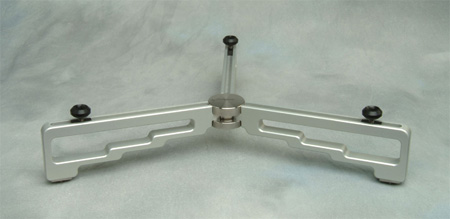
You are reading the older HTML site
Positive Feedback
ISSUE
26
stillpoint
Component Stands
as reviewed by Francisco Duran

|
Our highly resolving audio systems are sensitive to many outside influences, including electromagnetic fields, vibration, and dirty power. In my system, two Balanced Power Technologies line conditioners have the electricity covered. As for vibration, my home-brewed rack was designed with two purposes in mindósturdiness and ease of use. It is convenient for installing and removing gear, which I seem to be doing constantly. I made the shelves out of a combination of pine, Bluetak, and MDF, and my brother did the metal work. After a side trip to the local powder-coating shop, I had a functional, inexpensive rack that even sports adjustable, spiked feet. I did not do measurements with a spectrum analyzer, and didnít tap the rack with a mallet to find the weak spots, but I did design the rack to have the luxury of ten inches of space between each of the four shelves, so that all pieces of gear could be supported by vibration control devices. I have quite an assortment, and have even made some of my own.
The Stillpoint Component Stands are quite a bit more expensive than any of my other vibration control devices, but as soon as I examined one, I could see that its engineering and craftsmanship justified the price. The Stillpoint stands are lightweight, but sturdy, versatile, and functional. They are designed to fit under just about any audio product, and I tried them under every component in my arsenal.
I started by placing one Component Stand under my Margules U280 SC tube amp. The improvements were immediately apparent, so I tried two of them under my Antique Sound Labs tube monoblocks, and was rewarded with the best sound I have gotten from these amps. Next, I placed one Component Stand under the Margules amp and the other under my Original 2008Mk II CD player. Then I tried using just one under the CD player. My speakers were the next to get the Stillpoint treatment. Finally, I placed a Component Stand under my Balanced Power Technologies power conditioner. The improvements were similar in every case, so I will speak in general terms about what the Component Stands do.

With the Stillpoint Component Stands, no single quality emerged at first listen. Instead, there was an across-the-board improvement in the sound of every component they were placed under. It seemed that the Stillpoint stands were making it possible to hear the full potential of my gear, allowing the components to sound the way they were designed to sound. Of course, there is no way to know whether the manufacturers use them in the design process, but if they donít, they should! In fact, the improvements in the sound of my components with the Stillpoint stands in place made me wonder if the manufacturers really heard their products the way they were meant to sound. The Stillpoints are that good!
All of the vibration control products I have tried seem to color the sound, making it either warmer or brighter. This is not the case with the Stillpoint Component Stands. With the Stillpoints, a subtle but substantial transformation of the sound occurs. Music sounds more natural. "Natural" means many things to many people, but to me it means that an audio system sounds like a live musical event. The Stillpoint stands improve clarity and transparency. You hear more within the soundstage. You also hear it against a cleaner background, and the effects do not sound artificial. Dynamics are improved, but not at the expense of timing. Instruments and voices sound more focused and coherent, and again, all of the improvements sound relaxed and natural.
Bass instruments are more clearly defined. On the song "Low Rider," by the group War, I could follow the blend of bass, drums, percussion, and keyboards much more easily. Bass guitars sounded more agile. Plucked notes popped out with more energy, snap, and focus. Even the harmonics improved, but the fluidity and pace of the music was never curtailed. In fact, most of the tracks on Warís Greatest Hits were good examples of the improvements caused by the use of the Stillpoint stands.
It may sound like I am exaggerating the effects of the Stillpoint Component Stands, but I promise you I am not. Are the Stillpoints worth the asking price? If you measure their worth by the degree of improvement that just one unit accomplishes, the answer is a resounding yes. Is the improvement equal to the one brought about by changing cables? Absolutely. Changing a component? Yes. In fact, I have often heard less difference when swapping CD players, or even amplifiers. The Component Stands proved themselves to be more neutral and transparent than any other vibration control device I have tried. If you are starting to build your system, and want to build it on a solid foundation, the Stillpoint Component Stands are a great place to start. If you are looking to wring that last bit of sound quality from out of your system, adding Component Stands will be a smart move. Even if you are just bored, and want to play with some cool devices, you should give the Component Stands a try. Francisco Duran
Component Stand
Retail: $799
Stillpoints
web address:
www.stillpoints.us
